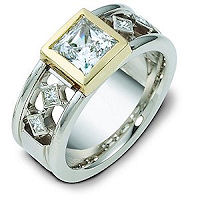
Diamond Composition and Properties
A diamond has a unique composition and a lot of different characteristics compared to other gems. It is no wonder that people are in awe of this beautiful gem.
Diamonds are made up of a single mineral called carbon. It is the only gemstone made from one mineral. Graphite is also made out of carbon; however, the difference between a diamond and graphite is the carbon atoms in a diamond are tighter than graphite. This is the result of high pressure environment in the Earth's surface. Another unique attribute
 of diamonds compared to carbon is diamonds are very dense compared to the low atomic weight of carbon. A diamond is a 10.0 on the Mohs
hardness scale. The Mohs hardness scale is a criterion for mineral identification and hardness. It relates to the resistance of being.
of diamonds compared to carbon is diamonds are very dense compared to the low atomic weight of carbon. A diamond is a 10.0 on the Mohs
hardness scale. The Mohs hardness scale is a criterion for mineral identification and hardness. It relates to the resistance of being.
Miners understand that diamonds repel water, which is a very uncommon characteristic for minerals. The bonding and carbon composition allows this to happen. Diamonds do take wax and grease. This is the way miners are able to decipher between diamonds, minerals, and other gemstones while mining. The process is minerals are washed out using a slope made of wax and grease. All the stones that stick to the slope, during this process, are diamonds: while all the other minerals are washed out. This process is generally called a "grease" table.
The mentioned above are not just the only unique characteristics of diamonds. Here are a few more intriquing properties of diamonds:
- Their brilliance and luster. Diamonds can refract light. It bends and slows the light that passes through the diamond. A diamond displays the maximum amount of reflectance for a transparent substance. This is called the "admantine" luster. One of the reasons it is important to buy diamonds for wedding rings, engagement rings and anniversary rings that are well cut and minimally flawed, like VS in clarity. It allows the light to pass through the diamond giving off the most brilliance and shine, which allows a person to enjoy the sparkle in their jewelry.
- Diamonds that are perfect crystals that are colorless in color are chemically pure. If there is nitrogen present in diamonds, then the diamond becomes yellow. If there is boron present, the diamond becomes blue. Diamonds are available in other colors such as red to viole, real white and black. These colored diamonds are difficult to understand scientifically.
- When jewelers talk about the "fire" from a colorless diamond, they are referring to the excellent dispersion separating white light. When looking at a diamond in a ring or piece of jewelry and the color of the rainbow reflects, this is known as the "fire" in a diamond.
- Some diamonds can glow in the dark. If the diamond is lit up with an ultraviolet light, some diamonds can absorb that high-energy radiation and re-emit it as visible light. Flourescent diamonds are generally the ones that glow in the dark and have this feature. If the diamond continues to glow after the ultraviolet light is turned off, then is is phosphorescent.
- Diamonds are lower in temperature than our bodies. This is a good reason the term "ice" is used for diamonds. They extract heat away from us. So, when a person touches a diamond to their lips, it will feel ice cold. The diamond is robbing our lips from heat. Diamonds are excellent thermal conductors. It is 4 times more than other gems and cooper.
© Copyright
1995-2024 WeddingBands.com. All rights reserved


